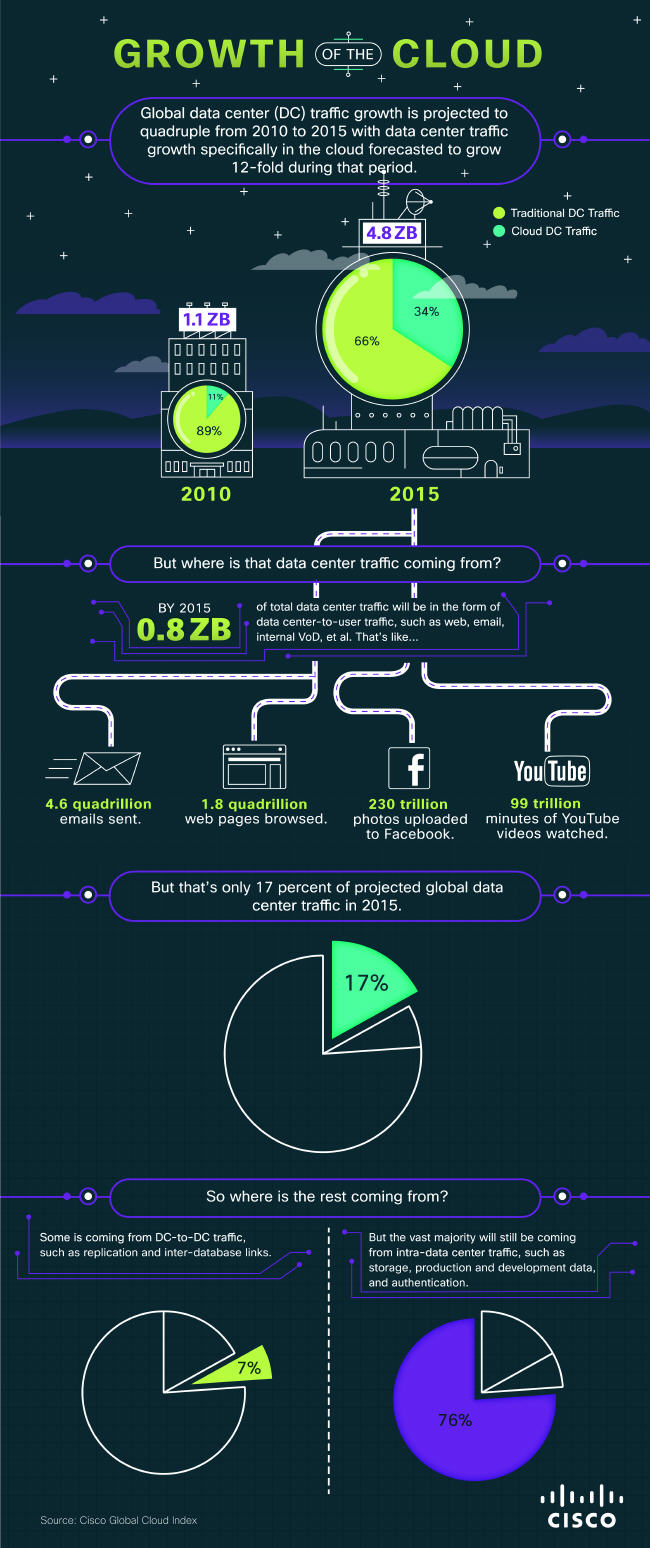Cloud computing traffic globally is expected to grow 12-fold from 130 exabytes to reach a total of 1.6 zettabytes annually by 2015, a 66pc compound annual growth rate, according to the inaugural Cisco Global Cloud Index.
Cloud is the fastest-growing component of data centre traffic, which itself will grow four fold at a 33pc CAGR to reach 4.8 zettabytes annually by 2015.
One zettabyte is equal to a sextillion bytes or a trillion gigabytes – 1.6 zettabytes is approximately equivalent to: 22trn hours of streaming music, 5trn hours of business web conferencing with a webcam or 1.6trn hours of online high-definition (HD) video streaming.
“Cloud and data centre traffic is exploding, driven by user demand to access volumes of content on the devices of their choice,” explained Suraj Shetty, vice-president of product and solutions marketing, Cisco.
“The result: greater data centre virtualisation and relevance of the network for cloud applications and the need to make sense of a dynamically evolving situation.
“The Cisco Global Cloud Index provides insight into this traffic growth and trends so that organisations can make strategic long-term decisions. We will continue to develop and release the Cisco Global Cloud Index on a regular and ongoing annual basis, contributing to ‘cloud readiness’ efforts worldwide,” said Shetty.
Cloud is also estimated today to be 11pc of data centre traffic, growing to more than 33pc of the total by 2015. Cloud is becoming a critical element for the future of information technology (IT) and delivery of video and content.
The vast majority of the data centre traffic is not caused by end users but by the data centres and clouds themselves undertaking activities that are largely transparent to end users – like backup and replication.
By 2015, 76pc of data centre traffic will remain within the data centre itself as workloads migrate between various virtual machines and background tasks take place, 17pc of the total traffic leaves the data centre to be delivered to the end user, while an additional 7pc of total traffic is generated between data centres through activities such as cloud bursting, data replication and updates.
The Cisco Global Cloud Index is generated from a modelling and analysis of various primary and secondary sources, including more than 30 terabytes of data generated each month over the past year from a variety of data centres around the globe, measurements of more than 45m broadband-speed tests and third-party market forecasts.
Cloud will account for one-third of data centre traffic by 2015
According to the index, cloud will account for one-third of total data centre traffic. Globally, cloud traffic will grow from just 11pc (11 exabytes per month and 130 exabytes annually) of total data centre traffic in 2010 to more than a third of total data centre traffic (34pc specifically – 137 exabytes per month and 1.6 zettabytes annually) by 2015.
The transition to cloud services is driving global cloud traffic at a growth rate that is twice as great as global data centre traffic. Global data centre traffic will grow fourfold (a 33pc CAGR) from 2010 to 2015, while global cloud traffic will grow 12-fold (a 66pc CAGR) over the same period.
Data centre traffic is forecast to more than quadruple from 1.1 zettabytes in 2010 to 4.8 zettabytes annually in 2015, representing a 33pc CAGR.
Of the data centre traffic in 2015, 76pc stays within the data centre itself, through such activities as storage and authentication across virtual machines.
Due predominately to the rise in video-based consumer services, data-centre-to-user traffic has some significant peaks in activity.
Much like prime-time viewing hours, the average amount of data centre traffic per hour during peak periods is expected to rise up to 2.5 times, requiring the need to plan for additional capacity from data centres and the cloud, as well as from the network. The on-demand model of cloud is perfectly suited to serve this type of variable demand.
In 2010, 21pc of workloads were processed in a cloud-based data centre, with 79pc being handled in a traditional data centre.
The year 2014 is the first year where the balance of workloads shifts toward the cloud for the first time – 51pc of total workloads will be in a cloud environment versus 49pc in the traditional IT space.
Overall, the data centre workload from 2010-2015 is growing 2.7 fold; however, the cloud workload from 2010-2015 is growing more than seven fold over the forecast period.
All regions included in the study – Asia Pacific, Middle East and Africa, Western Europe, Central and Eastern Europe, Latin America and North America – are currently ready for basic cloud-computing applications, such as social networking and web conferencing.
For intermediate cloud-computing applications, such as video chat and high-definition video streaming, Asia Pacific, Western Europe, Central and Eastern Europe, and North America were considered to have average network capabilities strong enough to support these services.
No region was assessed to be able to support advanced cloud applications such as high-definition videoconferencing and advanced gaming, in aggregate; however, certain countries within each region – such as Japan and South Korea – are currently able to do so.
